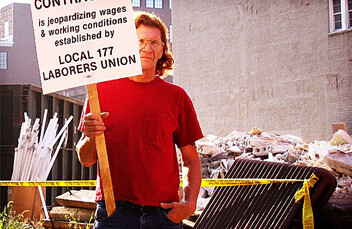In recent decades, many politicians, policymakers, and even some antipoverty advocates have come to the view that low-wage jobs are an inevitable part of a growing economy. Some go so far as to celebrate the growth of low-wage work and low-wage employers like Wal-Mart as part of a "progressive success story" benefiting workers, consumers, and owners of capital by lowering prices and increasing productivity.
Individuals who hold this view often acknowledge that low-wage work doesn't pay enough to make ends meet. To address this problem, they promote increased public funding for in-work benefits in order to "make work pay." These benefits, which are typically targeted to parents in low-income households, include ones that supplement cash income (the Earned Income Tax Credit), provide health insurance (Medicaid and SCHIP, which covers children), and offer direct assistance for other work expenses, expenses that, for higher-income workers, are subsidized in part through the tax code (such as child care and transportation). During the 1990s, the states and the federal government did expand some of these kinds of in-work benefits, while at the same time reducing the availability of income supplements (most notably, the now-defunct Aid to Families with Dependent Children (AFDC) and its replacement Temporary Assistance to Needy Families (TANF)).
According to the conventional view, the meager pay and limited benefits of low-wage jobs reflect the limitations of the workers holding these jobs, and increases in inequality and declines in middle-class jobs are explained by an increase in the return for skills and education driven by globalization and technology. Those who hold this view, including Federal Reserve Chairman Ben Bernanke, often acknowledge the problem of increasing inequality but put forward education and training as a silver bullet that will solve the problem.
Generally absent from this approach is any focus on reforming the labor market to improve the quality of low- and moderate-wage jobs. While some proponents of the make-work-pay strategy are simply agnostic on labor-market reform, others openly oppose reforms they characterize as "intervening" in the labor market.
The economic history of the last half a century in the United States suggests the agnostic approach will do little to promote shared prosperity. As MIT economists Frank Levy and Peter Temin have recently shown in an important National Bureau of Economics Research working paper, a greatly diminished role for labor-market institutions in promoting shared prosperity marks a significant difference between the recent decades of rising inequality in the United States and the immediate post–World War II period of mass upward mobility, when institutional concerns were at the forefront.
Of course, education, training, and in-work supports offer genuine benefits to low-wage workers. Where these policies are sufficiently generous and accessible, they can make a substantial contribution to improving the quality of life of low-wage workers. Nevertheless, an exclusive focus on low-wage workers rather than the failings of low-wage jobs has important limitations. The reality is that mobility out of low-wage work is surprisingly low. Most low-wage workers are adults already well into their work lives, not young people just starting out their careers. Recent research suggests that growth in low-wage (and very high-wage) jobs outpaced growth in middle-wage jobs in the 1990s, and projections of future employer demand suggests that most of today's low-wage occupations will be at least as numerous in the future as they are today.
More than 40 million jobs in the United States—about one in three—pay low wages. Even though expanding low-wage workers' access to high-quality skills training and education will help more low-wage workers move into better jobs, low-wage jobs constitute such a large share of jobs in the economy that expanded access to training and education provide only one prong of a multipronged strategy necessary to maintain and expand the middle class.
 An approach based on strengthening labor-market institutions complements, rather than conflicts with, the make-work-pay agenda. Key elements of such an approach include enforcing and enhancing existing labor standards such as the minimum wage and other wage and hour standards, and establishing new basic labor standards, such as minimum guarantees of paid vacation, sick pay, and parental leave. Another essential element is the strengthening and encouraging of collective bargaining through greater unionization. By improving the bargaining power of low-wage workers, unionization promotes better pay, benefits, and working conditions.
An approach based on strengthening labor-market institutions complements, rather than conflicts with, the make-work-pay agenda. Key elements of such an approach include enforcing and enhancing existing labor standards such as the minimum wage and other wage and hour standards, and establishing new basic labor standards, such as minimum guarantees of paid vacation, sick pay, and parental leave. Another essential element is the strengthening and encouraging of collective bargaining through greater unionization. By improving the bargaining power of low-wage workers, unionization promotes better pay, benefits, and working conditions.
In a new research study, we, along with Margy Waller and Ben Zipperer, take a closer look at the impact of unionization on the pay and benefits of low-wage jobs. The data suggest that even after controlling for differences between union and nonunion workers, union representation substantially improves the pay and benefits offered in what are otherwise low-paying occupations. On average, in the 15 important low-wage occupations we analyzed, unionization raised workers' wages by just over 16 percent—about $1.75 per hour—compared to similar, but nonunion, workers. The union impact on health-insurance and pension coverage in low-wage jobs was even bigger. Union workers in low-wage occupations were 25 percentage points more likely to have employer-provided health insurance, as well as 25 percentage points more likely to be in an employer-provided pension.
These union effects are large by any measure. Consider that between 1996 and 2000, a period of sustained low unemployment that helped to produce the best wage growth for low-wage workers in the last three decades, the real wage of 10th percentile workers rose, in total, about 12 percent. By comparison, at 16 percent, the union wage effect was one third larger than the full impact of four years of historically rapid real wage growth. Over the same boom period in the 1990s, health and pension coverage among the bottom fifth of workers rose only about three percentage points for health insurance (up 3.2 percentage points) and pensions (up 2.7 percent), about one-eighth of the impact of unionization on health and pension coverage among low-wage occupations we analyzed. The union effects are particularly impressive given the widespread belief that many of the jobs we examined are inherently incapable of providing decent pay and benefits.
The National Labor Relations Act, enacted by Congress in 1935, declares that it is the policy of the United States to encourage collective bargaining and to protect "the exercise by workers of full freedom of association, self-organization, and designation of representatives of their own choosing, for the purpose of negotiating the terms and conditions of their employment or other mutual aid or protection." While the NLRA remains on the books, unionization has steadily declined in the United States, in large part because of a failure to actively encourage and protect workers' full freedom of association.
The findings of our study demonstrate that the exercise of these basic and long-standing rights results in better wages and benefits for low-wage workers. Our findings complement other research, much of it summarized in the recent book What Do Unions Do? A Twenty-Year Perspective, suggesting that unions reduce employee turnover and wage inequality, and increase access to sick pay and annual leave. Taken together, these positive effects of collective bargaining argue that unionization is a key element of an effective strategy to build a stronger and more inclusive economy.
In this sense, unionization does more than boost wages. It also promotes social inclusion—the ability for workers, even those in low-wage occupations, to participate fully in the social and economic life of their communities.
Given the prevalence of low-wage jobs without benefits in our labor market, and the likelihood that these sectors will grow rather than decline, some attention to the strategy of improving the jobs is critical to strengthening our economy and communities. Unless these jobs are improved, our nation will permanently consign a large portion of workers in the United States to bad jobs. If this happens, we will be weaker as a nation.
![]() This article is licensed under a Creative Commons License.
This article is licensed under a Creative Commons License.
Please read our usage policy.





